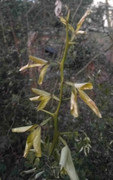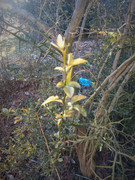This continues to be an educational experience. The local cold weather has been followed up by warmer temperatures and rain.
A few observations:
1. Poncirus leaves and twigs that appeared to be wilted and dying have re-hydrated remarkably quickly.
2. The combination of direct sunlight and frozen soil is very dehydrating.
3. Subzero temperatures with no wind on a clear night allows a super-chilled layer of air to form directly on top of the snow, which is very harmful, this layer was about 6" deep. I don't have record of the actual temperature of this layer, as the reading of -11.8 F. was about 30" above the snow.
4. The section of the stems above the bottom 6 inches showed considerable less damage than the lower 6".
5. The rather quick warming trend allowed some damage to be visible within days.
6. Some bark splitting is becoming apparent.
7. There will likely be additional observations over the next 6-7 weeks, perhaps longer.
8. Photos of Poncirus before warm up and after warmup and rain. This should be the same twig.
9. This Poncirus tree was planted in the early 90's.

